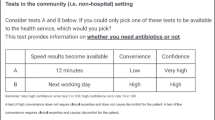Abstract
Objective Antibiotics may frequently be prescribed on the basis of vague diagnoses, possibly resulting in unnecessary antimicrobial resistance. Our aim is to map general practitioners’ (GPs’) decision-making for common infections, exploring their diagnostic basis for antibiotic prescriptions. Setting General practice in Iceland. Method Ten in-depth qualitative interviews with, and three observations of, GPs in 1995. Diagnostic issues extracted and analysed. In 2006, eight GPs commented on analysis and updated (email/telephone). Main outcome measure Diagnostic variability and reasons for prescribing antibiotics, consistency or changes over time. Results Wide variations were uncovered in diagnostic procedures, although each GP remained consistent through time. Some GPs had developed “rules-of-thumb”. They often balanced risks against issues like money, time, need for the workforce (perceived importance of the patient’s job), client’s need for job/earnings (perceived ability to afford a sick day) and doctor-patient relationship (risk of refusal adversely affecting the relationship). Perceptions of risk varied from focusing on resistance development to focusing on possible harm from untreated infections, also ranging between considering both to worrying about neither. Changes over time were not prominent but included increased point-of-care testing and the perception by GPs that patients were increasingly willing to “wait and see”. Conclusions Large variability and individuality characterized the GPs’ diagnostic procedures, contrasted by consistency through time. If modification of diagnostic routines is needed, provision of “scientific facts” and technological aids is insufficient. A prerequisite for changing practice is GPs’ acceptance of accuracy of information and of reliability, applicability, and relevance of technology, for physician and/or patient.
Similar content being viewed by others
Notes
In 1995 there were discussions about referrals from a GP, for granting patient’s access to specialists in other fields. These discussions had created a tug-of-war between GPs and specialists
References
Friedman CR, Srinivasan A. Public health responses to antimicrobial resistance in outpatient and inpatient setting, Chapter 16. In: Wax RG, Lewis K, Salyers AA, Taber H, editors. Bacterial resistance to antimicrobials, 2nd ed. Boca Raton: CRC Press; 2008. ISBN 978-0-8493-9190-3.
O’Brien MA, Rogers S, Jamtvedt G, Oxman AD, et al.. Educational outreach visits: effects on professional practice and health care outcomes (Review). Reprint of a Cochrane review, published in The Cochrane Library 2008(3). http://apps.who.int/rhl/reviews/CD000409sp.pdf. Accessed on 7 May 2010.
Björnsdóttir I, Hansen EH. Telephone prescribing of antibiotics: general practitioners’ views and reflections. Eur J Pub Health. 2001;11(3):260–3.
McGavock H, Webb CH, Johnston GD, Milligan E. Drug marketing: the most powerful external influence on prescribing. In: McGavock H, et al., editors. The prescribing jigsaw. Belfast: Drug Utilisation Research Unit, Queen’s University; 1998.
Wick A. The importance of diagnosis in general practice. Schweiz Rundsch Med Prax. 1993;82:68–76.
Kaplan RM. Uncertainty, variability, and resource allocation in the health care decision process, Chapter 14. In: Friedman HS, Silver RC, editors. Foundations of health psychology. New York: Oxford University Press; 2007. ISBN: 978-0-513959-4.
Gyssens IC, Kullberg BJ. Improving the quality of antimicrobial drug use can result in cost containment. Pharm World Sci. 1995;17(5):163–7.
Henriksen K, Hansen EH. The threatened self: general practitioners’ self-perception in relation to prescribing medicine. Soc Sci Med. 2004;59(1):47–55.
Bradley C. Insights from qualitative research are needed to improve GP prescribing. Eur J Gen Pract. 2002;8:3–4.
Strauss A, Corbin J. Basics of qualitative research: grounded theory procedures and techniques. Newbury Park: Sage Publications; 1990.
Janesick V. The choreography of qualitative research design: minutes, improvisations and crystallization. In: Denzin NK, Lincoln YS, editors. Handbook of qualitative research. 2nd ed. Thousand Oaks, CA: Sage Publications, Inc.; 2000. p. 379–99.
Hansen EH. Rationality and common sense in Danish drug therapy. J Soc Adm Pharm. 1988;5(3/4):105–13.
Björnsdóttir I. Studies in prescribing of antibiotics in Iceland: a qualitative and quantitative approach. Copenhagen: The Royal Danish School of Pharmacy, Department of Social Pharmacy, 1999.
Wigton RS, Darr CA, Corbett KK, Nickol DR, Gonzales R. How do community practitioners decide whether to prescribe antibiotics for acute respiratory tract infections? J Gen Intern Med. 2008;23(10):1615–20. doi:10.1007/s11606-008-0707-9.
Howie JGR. Some non-bacteriological determinants and implications of antibiotic use in upper respiratory tract illness. Scand J Infect Dis Suppl. 1983;39:68–73.
Fahey T. Bronchitis and sinusitis, Chapter 4.1. In: Gibson PG, editor. Evidence-based respiratory medicine. Oxford: Blackwell Publishing; 2005. ISBN: 978-0-7279-1605-1.
Sundberg M. Optical methods for tympanic membrane characterisation. Linköping studies in science and technology dissertation no. 1173. Linköping: Linköping University; 2008. ISBN 978-91-7393-933-1.
Appelman CLM, Claessen JQPJ, Touw-Otten FWMM, Hordijk GJ, de Melker RA. Severity of inflammation of tympanic membrane as predictor of clinical course of recurrent acute otitis media. BMJ. 1993;306:895.
Reid MC, Lane DA, Feinstein AR. Academic calculations versus clinical judgments: practicing physicians’ use of quantitative measures of test accuracy. Am J Med. 1998;104:374–80.
McIsaac WJ, Goel V. Sore throat management practices of Canadian family physicians. Fam Pract. 1997;14:34–9.
Paluck E, Katzenstein D, Frankish CJ, Herbert CP, Milner R, Speert D, Chambers K. Prescribing practices and attitudes toward giving children antibiotics. Can Fam Physician. 2001;47:521–7.
Howie JG. Diagnosis: the Achilles heel? J R Coll Gen Pract. 1972;22(118):310–5.
Coenen S, van Royen P, Vermeire E, Hermann I, Denekens J. Antibiotics for coughing in general practice: a qualitative decision analysis. Fam Pract. 2000;17(5):380–5.
Finch R. Bacterial resistance: the clinical challenge. Clin Microbiol Infect. 2002;8(Suppl 3):21–32.
Andre M, Borgquist L, Molstad S. Use of rules of thumb in the consultation in general practice: an act of balance between the individual and the general perspective. Fam Pract. 2003;20(5):514–9.
Gabbay J, le May A. Evidence based guidelines or collectively constructed “mindlines?” Ethnographic study of knowledge management in primary care. BMJ. 2004;329(7473):1013.
Cockburn J, Pit S. Prescribing behaviour in clinical practice: patients’ expectations and doctors’ perceptions of patients’ expectations: a questionnaire study. BMJ. 1997;315(7107):520–3.
Arason VA, Sigurdsson JA, Kristinsson KG, Getz L, Gudmundsson S. Otitis media, tympanostomy tube placement, and use of antibiotics. Cross-sectional community study repeated after five years. Scand J Prim Health Care. 2005;23(3):184–91.
Kristinsson KG. Modification of prescribers’ behavior: the Icelandic approach. Clin Microbiol Infect. 1999;5(Suppl 4):S43–7.
Lambert MF, Masters GA, Brent SL. Can mass media campaigns change antimicrobial prescribing? A regional evaluation study. J Antimicrob Chemother. 2007;59(3):537–43. doi:10.1093/jac/dk1511.
Anonymous. Use of drugs in Iceland 1996-2005. Icelandic Ministry of Health. http://www.heilbrigdisraduneyti.is/media/Lyfjamyndir/Notkun_lyfja_a_Islandi_1996-2005.pdf. Accessed 7 May 2010.
Armstrong D. Clinical autonomy, individual and collective: the problem of changing doctors’ behaviour. Soc Sci Med. 2002;55(10):1771–7.
Publications and reports (In Icelandic = Rit og skýrslur). The Directorate of Health (Landlæknisembættið). http://www.landlaeknir.is/Utgafa/Ritogskyrslur. Accessed 7 May 2010.
Clinical guidelines (In Icelandic = Klínískar leiðbeiningar). The Directorate of Health (Landlæknisembættið). http://www.landlaeknir.is/Kliniskarleidbeiningar. Accessed 7 May 2010.
Rosenberg W, Donald A. Evidence based medicine: an approach to clinical problem-solving. BMJ. 1995;310:1122–6.
Forde R. Competing conceptions of diagnostic reasoning: is there a way out? Theor Med Bioeth. 1998;19(1):59–72.
Fargason CA Jr, Evans H, Ashworth CS, Capper SA. The importance of preparing medical students to manage different types of uncertainty. Acad Med. 1997;72:688–92.
Acknowledgments
We thank our informants for the participation and Maxine Ingalls, RN, for proofreading.
Funding
Research is a part of our duties within our ordinary paid jobs. This research was done within that scope.
Conflicts of interest
We have no conflicts of interests to declare.
Author information
Authors and Affiliations
Corresponding author
Appendix 1
Appendix 1
Original guide = questions asked in 1995
-
Years in general practice?
-
What is your view regarding use of antibacterials? (on the slightest suspicion, only when based on cultures or somewhere in-between)
-
How do you prescribe for sore throat? (symptoms, treatment) For sinusitis? For infections in the respiratory tract? For UTI? For dermatological infections? Other infections?
-
For children? (probe for otitis here) Elderly people? Women versus men?
-
Usability and disadvantages of specific antibiotics? (groups)
-
Recall the last 10 [antibiotic prescriptions]. Any uncomfortable?
-
Do patients press? If yes, what do you think the reason is? (certain types??)
-
Time pressure?
-
Telephone prescriptions. How decided?
-
Fear of resistance problems?
-
Laboratory facilities in the town?
-
Cost to patient?
-
Composition of wages?
-
The secretary/the telephone lady?
-
Co-operation between the physicians?
-
(The referral case?)Footnote 1
-
Co-operation with pharmacy?
-
Anything you would like to add, - or anything I forget to ask about?
Supplementary questions = questions asked in 2006
-
How have your prescribing habits regarding the most common infections changed during these 10–11 years from the initial interview?
-
(common infections: otitis, sinusitis, sore throat, UTIs, pneumonia, dermatological infections)
-
If changes—why do you think the changes occurred?
-
Have there been changes in your prescribing of azithromycin, ciprofloxacin and doxycyklin (official sales statistics indicate changes in the use of these drugs)
-
What is your view regarding the development in resistance to antibiotics?
-
What is your opinion regarding the authorities’ response to that development?
-
What is your view regarding your prescribing habits for antibiotics?
-
Do you think your prescribing is on a suitable level, or is your antibiotic prescribing on a level that you consider unfortunate in some way?
-
Why?
-
What is your view regarding your colleagues’ prescribing of antibiotics?
-
Is their prescribing on a suitable level, or is it unfortunate in some way?
-
Why?
Rights and permissions
About this article
Cite this article
Björnsdóttir, I., Kristinsson, K.G. & Hansen, E.H. Diagnosing infections: a qualitative view on prescription decisions in general practice over time. Pharm World Sci 32, 805–814 (2010). https://doi.org/10.1007/s11096-010-9441-6
Received:
Accepted:
Published:
Issue Date:
DOI: https://doi.org/10.1007/s11096-010-9441-6




